Our work with David & Richard at Proto Studios in Pewsey, Wiltshire has now come to an end.
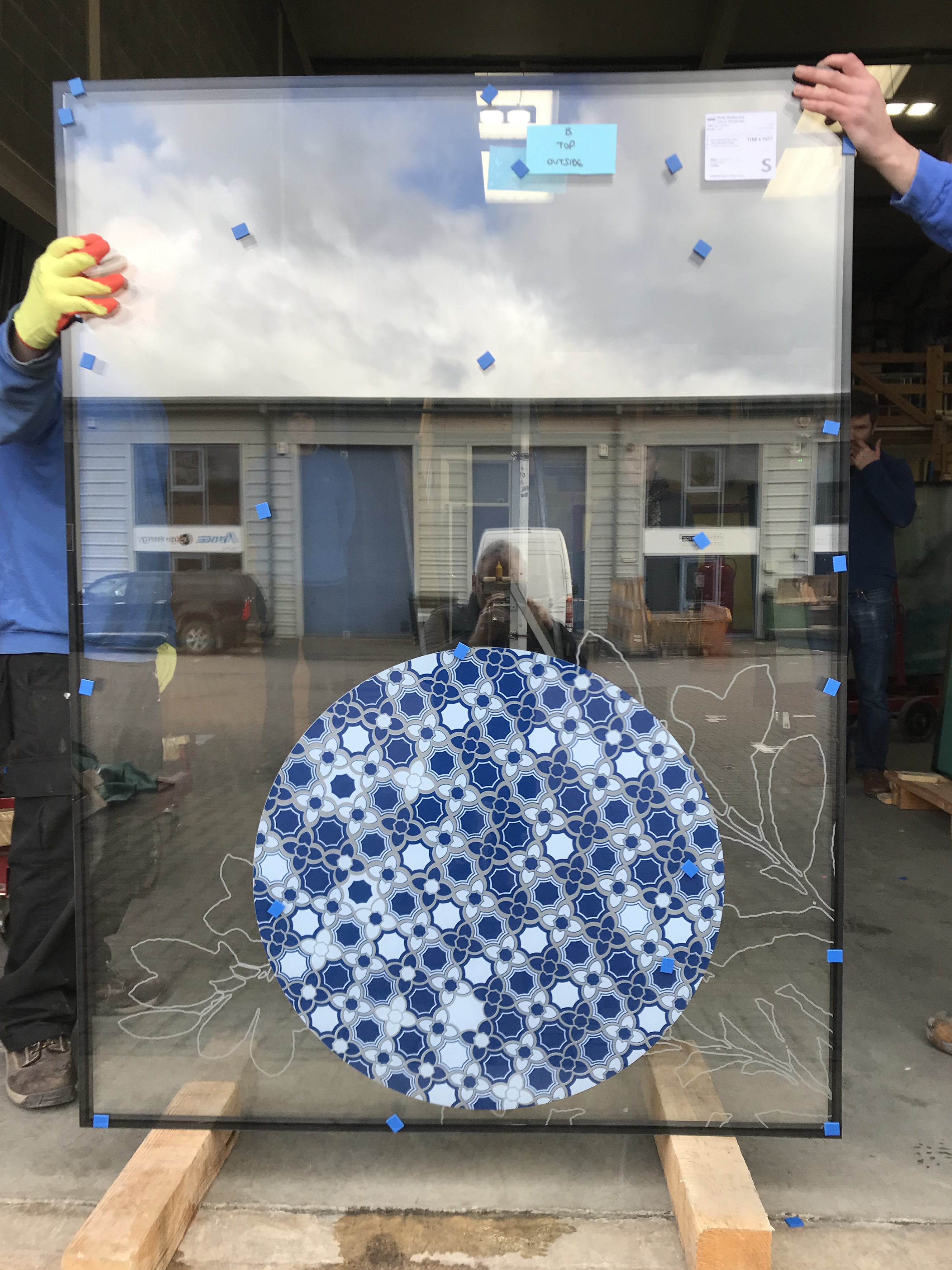

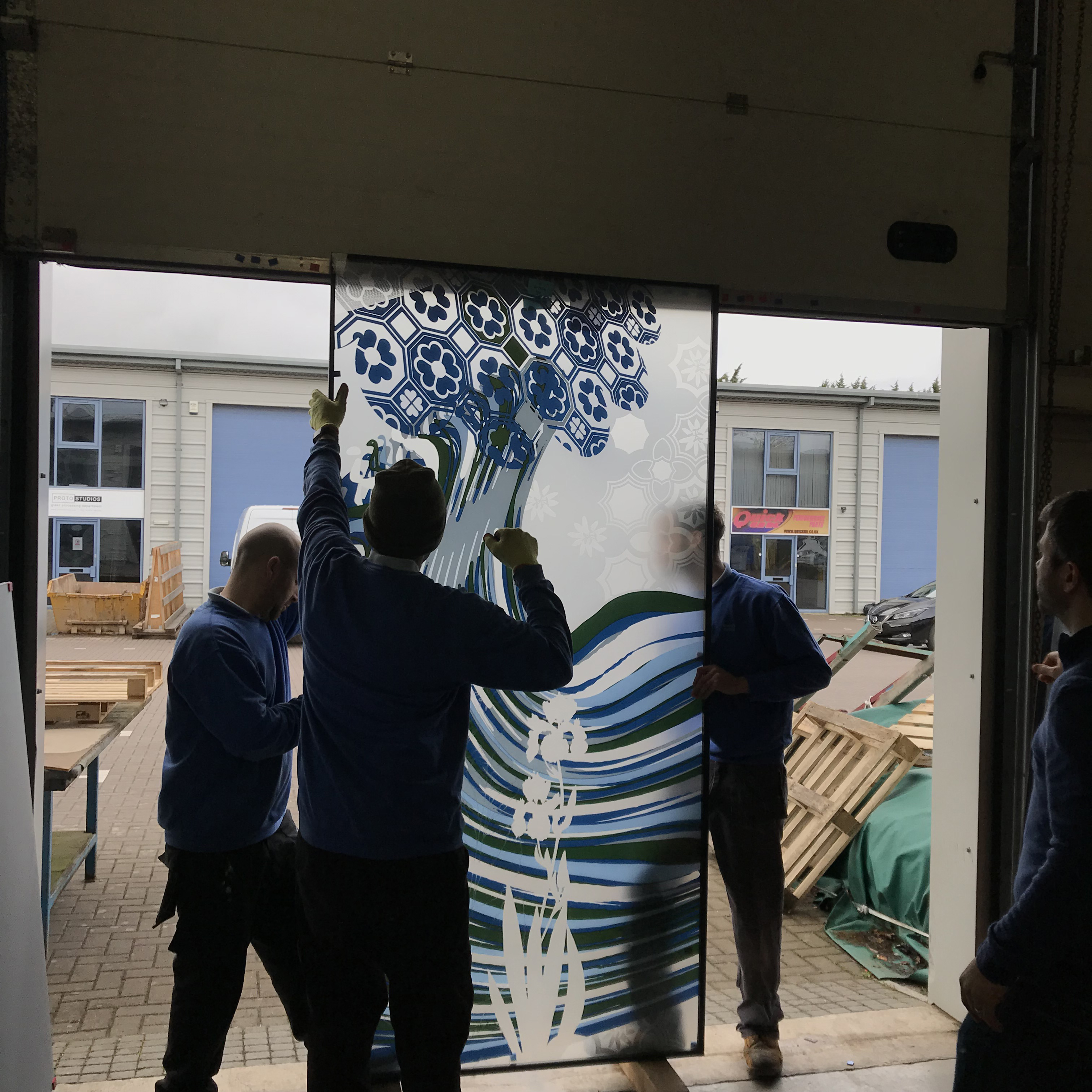

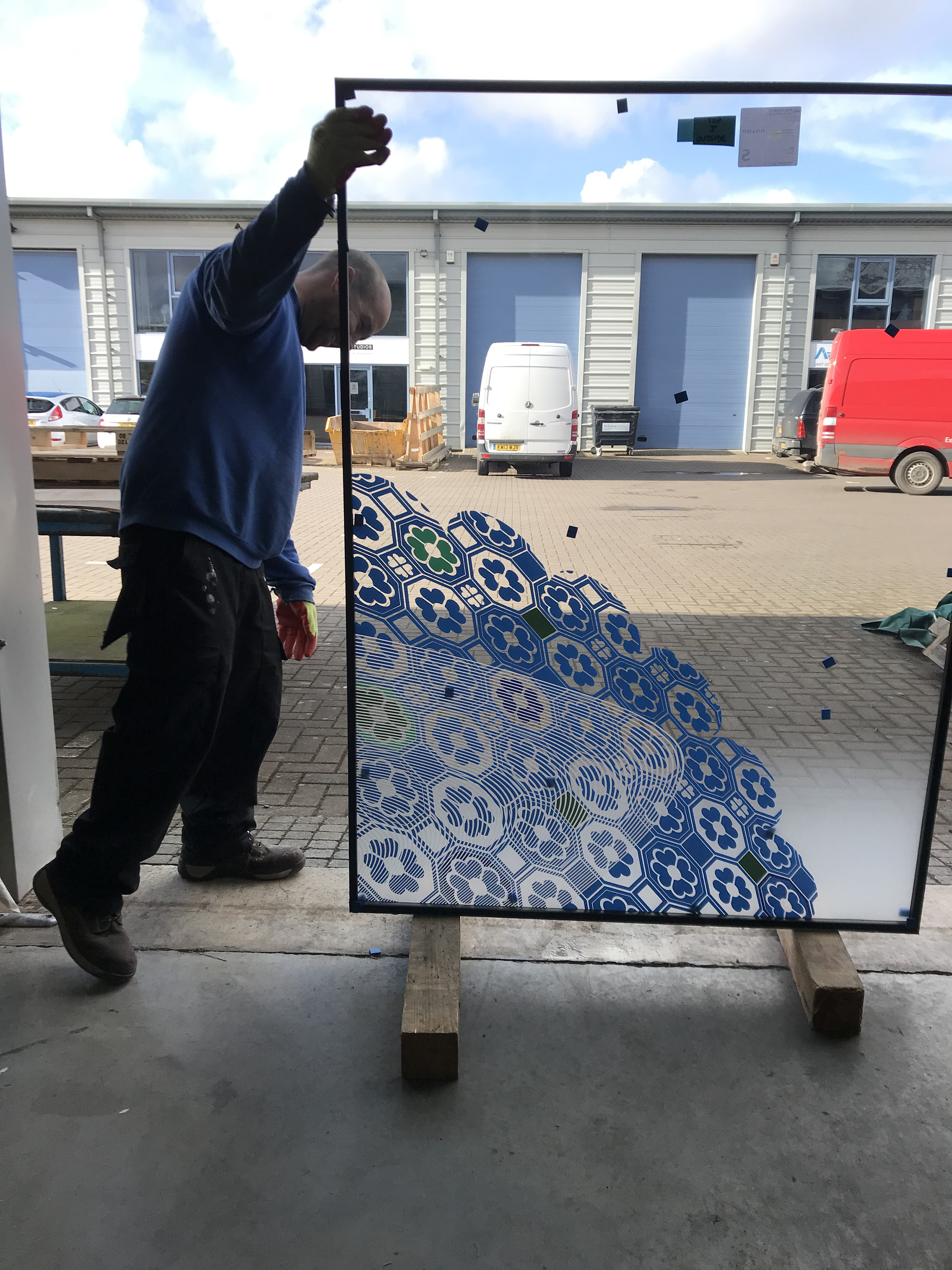







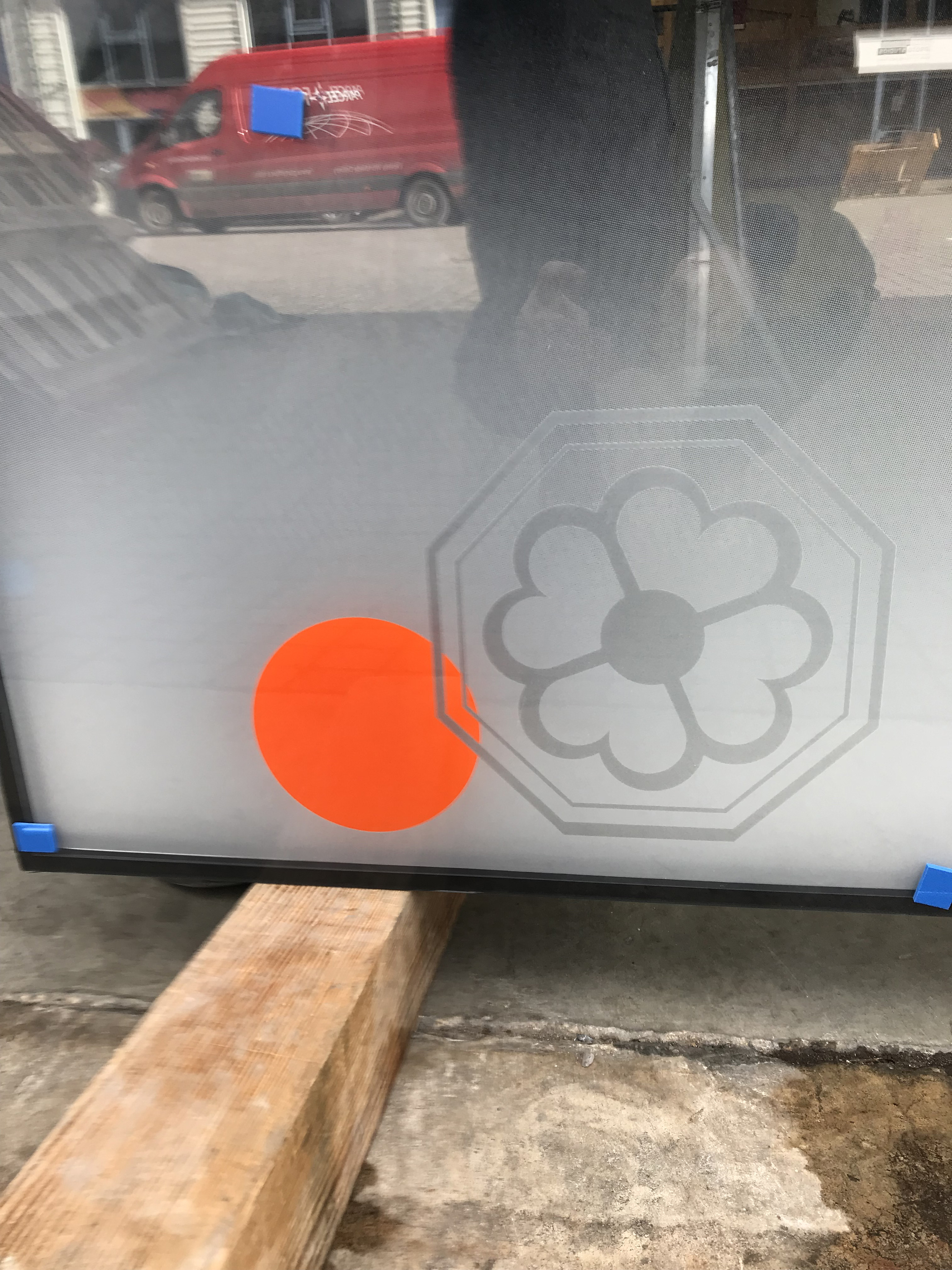
I imagined an abstracted landscape as a positive way of encapsulating all that has inspired my commission for the Hydrotherapy Pool glazed screens. (There are approximately 46sqm of glass combined in both screens).
Both Hospital sites were originally set in and adjacent to open fields and expansive views of countryside. Easy to imagine then how beneficial this must have been to those patients and staff who experienced this.
It is now commonly understood that exposure to natural spaces, planting and nature within medical and healing environments is of great benefit and assists in the recovery and positive experience of patients and staff alike.

This glass landscape is populated with recognisable motifs, such as flowers, deer and trees, woven together with abstract forms and repeating patterns. Local landmarks such as Kelston Round Hill also feature, as do references to the architectural decoration and built heritage of The Min and its archaic Roman Mosaics. However, the most visible motif perhaps is water, and more explicitly, the gestural movement of water as shaped by those taking treatment in the Hydrotherapy Pool. A shape made in water informed by the movement of a hand or leg. Abstractions of steam or mist appear to hover in this landscape. Water is contained within a bowl or pool. An elegant but dynamic abstract splash of water drifts across the whole of the East Screen. The connection to hot springs and flowing waters has shaped Bath into the World Heritage Site we see today.
I have been so impressed with the positivity and care of the medical staff delivering these services, I wanted to evoke this caring nature with visual clues within the work, which may express this. Growing flowers and creating gardens is a nurturing vocation. Water is an elemental part of this. Historically, The Min was built upon the grounds of the first Theatre in Bath, and the later extension built upon the formal gardens of Rectory House. Adjacent to the ChapeI at the rear of The Min is a small but lovely garden. Also in Bath, Gibbes Garden was a 15th Century apothecary garden growing medicinal herbs.
Combe Park had formerly been the site of the Bath War Hospital built in 1916 to provide beds and medical services for WW1 Casualties. There was a small pond and a stream ran nearby. Patients and staff were encouraged to grow and maintain flower gardens & were rewarded with prizes.
I was offered a session at the Hydrotherapy Pool at The Min as a way of understanding a little more about the impact of water as a treatment. I am not a patient – I cannot experience this as many do on a daily basis, not I am I in the process of healing or tempering acute conditions. Patients vary from those with lifelong conditions, such as Ankylosing spondylitis and others suffering from chronic pain, to physiotherapy in the pool following operations or broken limbs. All I can aim for is to add to the interior space with something visually interesting / beautiful / stimulating to this brand-new environment, which makes the experience for both staff and patients a pleasant and perhaps an intriguing one.
The following images make up the final draft artwork approved for production by the RUH. The Magenta/Pink colour is used to indicate clear/fully transparent glazing with no artwork. White represents sandblasting and / or Ceramic Etch techniques. All other colour is created using Screen-printed Ceramic Colour fired onto the glass. The artwork is applied to the two inner faces of a double glazed sealed unit. There is a subtle overlaying of motifs, which means that the artwork is slightly different as seen from the interior, than the exterior. These drafts are created initially via hand drawing and assembled and finished in Adobe Photoshop and Illustrator.








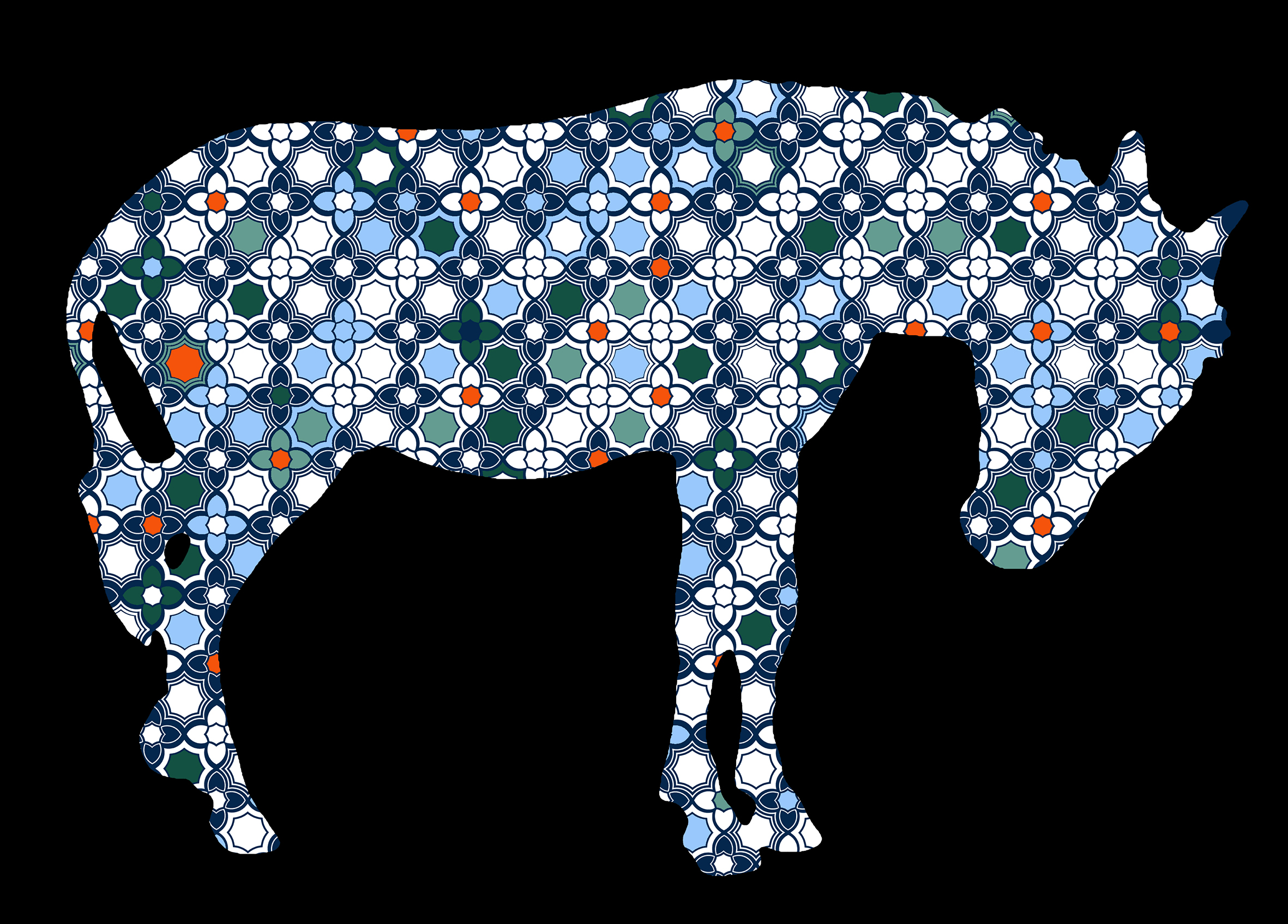






There are many threads of research and interest which have influenced the development and visual narrative of the artwork. The following notes and lists are from my own notebooks, where I made records of research sessions and information which struck me as inspirational.
The Mineral Water Hospital, affectionately known as The Min, was built in 1742 & overlooked open, ‘quiet fields’ and countryside. The Hospital was constructed on the site of Bath’s first Theatre of 1705, by the Architect George Trim, whose Mother was, apparently the sister of the Kings Architect, Inigo Jones. The theatre was demolished 1738.
This theatrical & dramatic connection has influenced the concept of using the glazed Hydrotherapy screens as inspirational painted backdrops – a way of creatively setting the scene within the new space & enhancing the experience of staff and patients using the Pool.
In 1859, with great ceremony, the foundation stone was laid for a new hospital building adjacent to the original site and built upon the grounds of a ‘large formal garden belonging to the Parsonage of St Peter Paul Parish’. This garden is shown on the John Speed map of 1610.
The new Royal United Hospital was built in open fields at Combe Park in 1932 (having moved from central Bath). Combe Park had formerly been the site of the Bath War Hospital built in 1916 to provide beds and medical services for WW1 Casualties. There was a small pond and a stream ran nearby. Patients and staff were encouraged to grow and maintain flower gardens & were rewarded with prizes.

In the Building Report on The Mineral Water Hospital, by The House Historians, March 2006, there is a detailed report on The Chapel, (now the home of Bath Medical Museum)and its architectural decorations.
This mentions a number of plants seen in carvings, stained glass and other architectural details, which are wonderfully useful in referencing the legacy of The Min, when it finally closes its doors to move to the RUH site:
Ivy
Oak
Water Buttercup
Wild Poppy
Fig
Vines
White Lilies
Passion Flower
Pomegranate
Hyssop
Colour and pattern used within the stained glass is also influential. Patterns are influenced by the architectural decoration and tiling of The Min Chapel.
Various hydrotherapy treatments, methods and equipment as described as being newly installed in 1915 following extensive alterations, are also very evocative and inspire some abstract interpretation within my creative narrative.
Deep Baths
Aix and Vichy Douches
Scotch and Needle Douches
Reclining and Vapour Baths
Radiant Heat Baths
Sulpher Baths of Potassium Sulphide
Mineral Water Baths
Whirlpool Bath
Hubbard Tank to treat the entire body simultaneously
‘A Vichy Massage required the patient to stand on a rubber covered slab whilst showered with jets of hot mineral water. The needle bath was a circular shower with an array of horizontal pipes which sprayed fine jets of water’.
Descriptions of the Coat of Arms for the Royal National Hospital for Rheumatic Diseases – to give The Min its formal & proper title, is a useful source of colour references, decorative motifs, plants, animals and their meaning.
Black
White for truth, sincerity, peace, innocence and purity
Green
Blue
Purple
Circlet of Fountains
Foxglove
Hares
Meadow Saffron
I like the colour of evening sky, that particular shade of indigo blue.
Water is by turns fluid and abstract, vaporous & ephemeral, contained within many shapes – rivers, ponds, streams, pools, baths, glasses & oceans – any number of vessels.
My creative approach is making connections between place & historic legacy, hydrotherapy practice and an imaginary landscape, which may be conjured up whilst being treated in the pool & feeling the benefits of floating & exercising, whilst being supported by warm water and the care and assistance and encouragement of staff.
‘This hospital was to be entirely self-funded, and even before the hospital was built the raising of monies for it began in earnest. Bath’s Master of Ceremonies, Richard Beau Nash arranged balls and collected subscriptions; wills, donations and even bequests of a diamond, and 1,000 oranges, contributed to the coffers. The list of donors reads like a Who’s Who of 18th century Bath society. Those who donated £40 or more were invited to become a hospital governor, including the artist William Hoare and the actor David Garrick’.
https://thebathmagazine.co.uk/finding-the-cure/

This Estate Map above – date unknown – shows the private estate of Weston Manor before the RUH incorporated it into its site in the 20th Century.
‘The hospital moved to its present site, Combe Park, on 11 December 1932. The site had previously been used for the large First World War Bath War Hospital which opened in 1916. In November 1919 it was renamed the Bath Ministry of Pensions Hospital, which it remained until it closed in 1929.
The site was also used by the Forbes Fraser Hospital and the Bath and Wessex Orthopaedic Hospital, both founded in 1924 and which merged into the RUH about 1980. The former manor house on the site, originally medieval but remodelled in the 18th century, became an administrative building. The building is a Grade II* listed building due to its fine Adam style interior’. Wikipedia

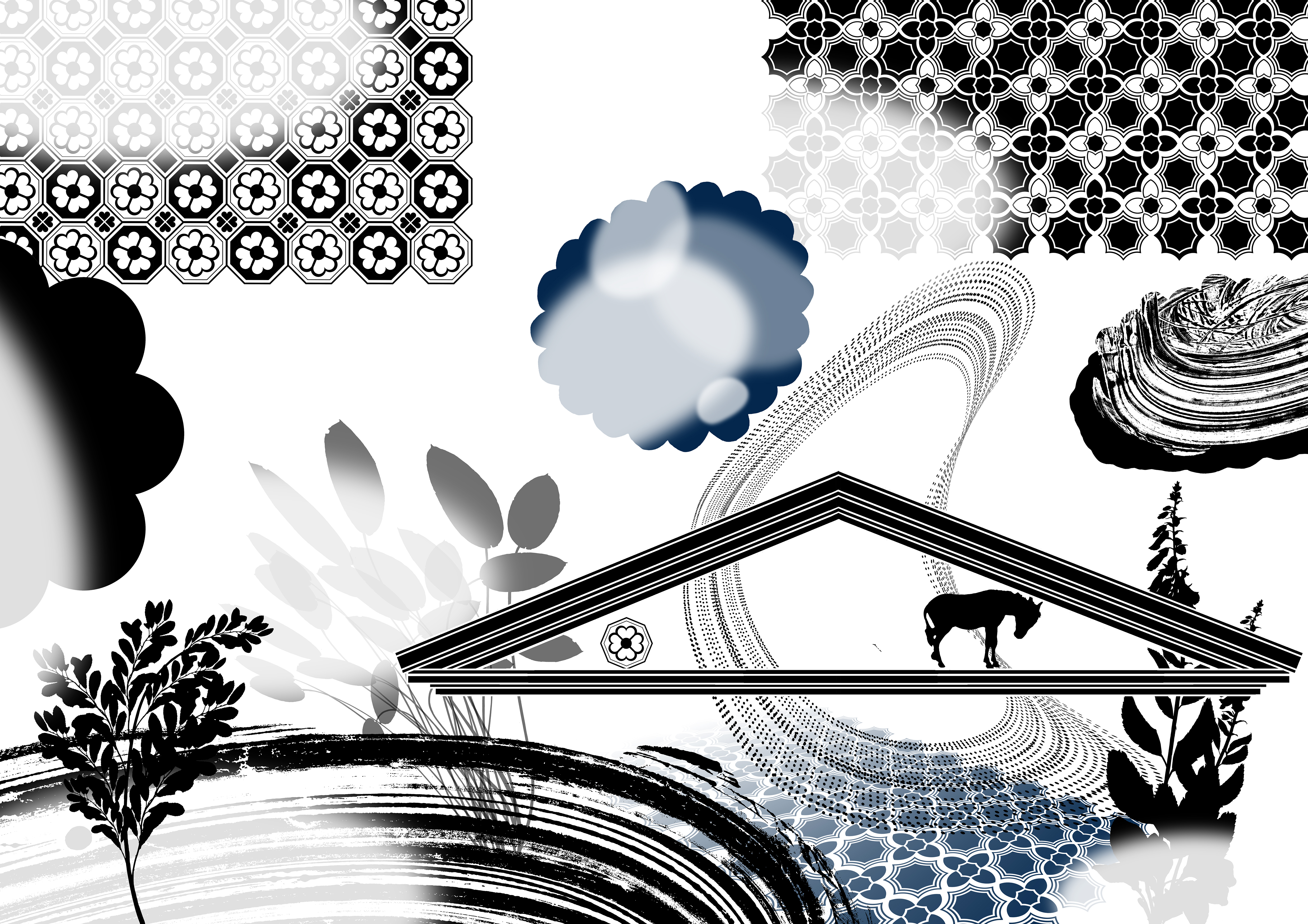











The panels are due to be installed in the next few weeks. Fingers crossed for a hassle free installation…watch this space!
Above: Safe in skilled hands…glass technicians carefully present each of the 18 double glazed sealed units for us to see.